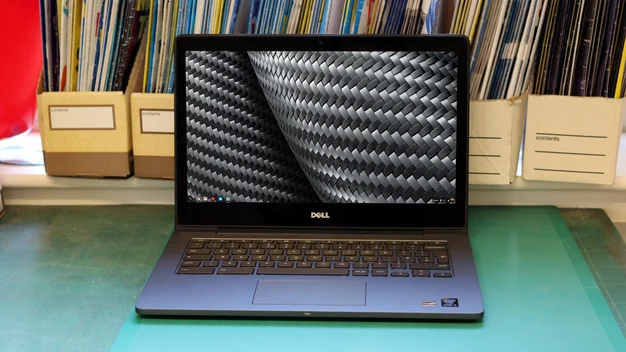Dell Chromebook 13
Dell Chromebook 13 review – a Chromebook Pixel rival?

The Chromebook 13 is a welcome premium Chromebook option, but the top-end model is very expensive
If most of your daily computing tasks take place inside your internet browser, then buying a Chromebook has often been a great low-cost alternative to getting a full-blown Windows laptop. Chromebooks from the likes of Acer and Toshiba, for example, only cost between £200 and £300, but you do get what you pay for, as their designs, performance and build quality are usually relatively basic.
However, ever since Google introduced its first Pixel Chromebook, a new breed of ‘premium’ Chromebooks have started to appear alongside their budget-oriented cousins, and Dell’s own Chromebook 13 definitely falls into that latter, top-end category.

Configurations
There are five models in total in Dell’s Chromebook 13 range, with prices ranging from £484 right up to £913 ex VAT. That might sound like a lot for a laptop that’s essentially a glorified internet browser, but the variety of models does, at least, offer a bit more flexibility to Google’s one-size-fits-all Chromebook Pixel.
They all share the same 13.3in 1,920×1,080 resolution display, which can be configured with touch or non-touchscreen panels, but each one has a very different set of internal components. The entry-level model, for instance, only uses an Intel Celeron 3205U processor, whereas the two mid-range models use an Intel Core i3-5005U. The top of the range model I reviewed here has a dual-core 2.3GHz Intel Core i5-5300U. This model also comes with 8GB of RAM, but the bottom three models only have 4GB. Likewise, lower-end models come with 16GB of storage, but the more expensive options have 32GB.
Needless to say, the higher-end models place the Dell Chromebook 13 in direct competition with Google’s Chromebook Pixel, but the Chromebook 13 doesn’t come out quite so well when you compare the two side by side. For instance, the top-end £999 Chromebook Pixel comes with a Core i7 processor, 16GB of RAM, 64GB of storage as well as Google’s impressively high-resolution 2,560×1,700 display, which is significantly more than what you get with the top-end Chromebook 13.
Design
Dell makes up for this, however, with its premium build quality. The outer lid has a stunning carbon fibre finish and the main chassis is made from magnesium alloy. It’s almost like an inverse XPS 13 or XPS 15, as Dell’s moved the carbon fibre finish from the inside of the laptop to the outside. In terms of how it feels, it would be right at home in Dell’s XPS range, and it’s a beautifully made device that puts other Chromebooks to shame.
There’s a nice soft touch finish to the chassis that feels pleasant under your hands. This makes it easy to grip, too, so transporting the Chromebook 13 isn’t a problem. The touchscreen model weighs 1.62kg, making it a fraction heavier than the Chromebook Pixel, but the non-touch model is lighter at 1.47kg. At its thickest point, the Chromebook 13 measures 16.7mm, but it tapers to 12.8mm at the front, giving it a much more eye-catching design than the uniform Chromebook Pixel.

Keyboard and Touchpad
The Chromebook 13 has a comfortably-sized backlit keyboard that’s very pleasant to type on. The keys don’t have the greatest amount of travel, but I didn’t encounter any problems with my keystrokes being registered. It’s reasonably quiet, too.
The keyboard has the usual nuances associated with Chromebooks, such as the Search button that can be configured to do different tasks, such as quick searches or act as a Caps Lock key when it’s toggled to function. You can also access an array of shortcuts in combination with the Alt, Shift and Search keys.
The precision touchpad is a decent size, too, although it’s not as big as the generously-sized touchpad on the Pixel. Thankfully, it’s a more than worthy rival to the Pixel’s touchpad when it comes to speed and accuracy. It has a nice glass coated surface so swipes glide across with minimal effort, and all of Chrome OS’s multitouch gestures work wonderfully.
The touchpad-based navigation is one of my favourite aspects of Chrome OS. As the operating system is essentially built around the Chrome browser, browsing the web is a delightful experience. Three-finger horizontal swipes swap tabs, while two finger swipes navigate backwards and forwards. Three-finger vertical swipes bring up Chrome OS’s equivalent of Windows 10’s Task View, too, so you can easily swap between tabs and apps.

| Core specs | |
|---|---|
| Processor | Dual-core 2.3GHz Intel Core i5-5300U |
| RAM | 8GB |
| Memory slots (free) | 1 (0) |
| Max memory | 8GB |
| Dimensions | 323x226x18.4mm |
| Weight | 1.62kg |
| Sound | 3.5mm headset port |
| Pointing device | Touchpad, touchscreen |
| Display | |
| Screen size | 13.3in |
| Screen resolution | 1,920×1,080 |
| Touchscreen | Yes |
| Graphics adaptor | Intel HD Graphics 5500 |
| Graphics outputs | HDMI |
| Graphics memory | Integrated |
| Storage | |
| Total storage | 32GB SSD |
| Optical drive type | None |
| Ports and expansion | |
| USB ports | 2x USB2 |
| Bluetooth | 4.0 |
| Networking | 802.11ac Wi-Fi |
| Memory card reader | MicroSD |
| Other ports | None |
| Miscellaneous | |
| Operating system | Chrome OS |
| Operating system restore option | Restore partition |
| Buying information | |
| Parts and labour warranty | One year collect and return |
| Price inc VAT | £1,095 |
| Details | www.dell.co.uk |
| Supplier | www.dell.co.uk |
| Part number | CA007CHB7310UK |
Read more
ReviewsDell Chromebook 13 review - a Chromebook Pixel rival?
ChromebooksThe Chromebook 13 is a welcome premium Chromebook option, but the top-end model is very expensive

